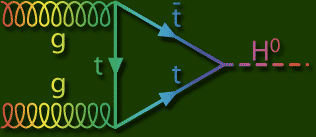C reative
Particle
Higgs
CPH Theory is based on Generalized light velocity from energy into mass.
CPH Theory in Journals
|
Perturbative QCD effects
|
|
H ! WW ! ℓνℓν signal at the Tevatron
Tevatron Higgs Limits Strengthened by a New Theoretical Study
A new
paper in the Arxiv attracted
my attention this morning. It is titled "Perturbative QCD
effects and the search for a
The paper is quite technical and a detailed discussion of its
content does not belong here. However, given the importance of
its results, I wish to provide with a short summary those among
you too lazy to download the paper.
The authors consider the effect of Next-to-Next-to-Leading order
(NNLO) corrections to the process of Higgs boson production by
gluon-gluon fusion at a hadron collider (as in the graphic: a
triangular loop of top quarks "connects" the gluons to the
Higgs), followed by the decay of the Higgs to two W bosons.
The figure above shows, as a function of the Higgs boson
mass (on the horizontal axis), the 95% CL limit obtained by the
Tevatron experiments, once they combined the results of all
their Higgs searches. The full black line shows the actual
limit, while the dashed one (surrounded by 1- and 2-sigma bands)
shows the expected sensitivity of the experiments. The pink band
on the left shows what mass range of the Higgs boson has been
excluded in the past by the LEP II experiments at CERN, while
the one on the right is the Tevatron exclusion region. The
vertical axis has units of the "times the Standard Model"
limits: an exclusion at, say, 5 times the SM for a mass of 130
GeV implies that a Higgs boson production with a rate five times
higher than what the Standard Model predicts is excluded by the
experiment; an exclusion of 1.0 or less means that Standard
Model Higgs boson is ruled out in the corresponding mass range. To the best of our knowledge, so far there has been no study of how the distributions of ANN outputs are modified at higher orders in perturbation theory. Here we present for the first time an ANN output distribution, computed at fixed order in perturbation theory, beyond the leading order. [...]in Fig. 9 we compare the ANN distribution obtained at NNLO QCD and with PYTHIA. We see that PYTHIA, even after rescaling with an inclusive K-factor, yields predictions which are smaller by 12-20%, depending on the chosen bin. This difference can be traced back to the difference in efficiency already observed at the level of the selection cuts placed on the kinematic input distributions.
Figure 9 is shown below. I cannot describe in detail the input
of the neural network that the authors have used to generate
this output shape; they are kinematical distributions obtained
at generator level (i.e., without any detector effect factored
in). With that in mind, we observe that the NNLO-computed cross
section (in red) is always above the one computed by PYTHIA (in
blue) over all the NN output range. The shape is instead in very
good agreement.
The authors conclude as follows:
[...]we find that the acceptance computed with PYTHIA is between
12% and 21% smaller than the NNLO acceptance, depending on the
choice of the factorization and renormalization scale. This
result is not significantly altered by hadronization and
underlying event and appears instead to be related to the matrix
element and parton shower implementation in PYTHIA itself. Since
the Tevatron analyses are based on PYTHIA, we believe that this
effect could be important and requires a more detailed
investigation within the framework of the full experimental
analysis.
Now, what does this imply for the Tevatron limits on the Higgs
boson ? Of course, if a limit on the existence of the Higgs
boson is computed by NOT observing a certain number of signal
events in the NN distribution, the limit becomes stronger if one
finds out that the Standard Model actually predicts more signal.
So we conclude that the Tevatron results are actually
conservative, and their power of exclusion is slightly stronger. Related Articles Here on Scientific Blogging
Source: Scientific blogging of Arxiv
1 2 3 4 5 6 7 8 9 10 Newest articles
|
|
Sub quantum space and interactions from photon to fermions and bosons |
Interesting articles
Since 1962 I doubted on Newton's laws. I did not accept the infinitive speed and I found un-vivid the laws of gravity and time.
I learned the Einstein's Relativity, thus I found some answers for my questions. But, I had another doubt of Infinitive Mass-Energy. And I wanted to know why light has stable speed?

